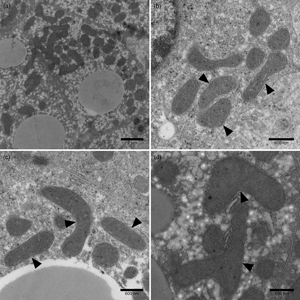Published online by Cambridge University Press: 23 March 2022

Hibernation is a biological status during which hibernating animals acclimatize themselves to reduced energy consumption through extreme but governed decline in self-metabolism. The role of mitochondria (Mt) in metabolic suppression during hibernation has already been elaborated in different organs and species. Nonetheless, the concretely changing process of mitochondrial architecture and the mechanism underlying this transformation during hibernation remains unclear. Herein, the present study was aimed at clarifying the detailed alteration of mitochondrial morphology and its potential role in the Chinese soft-shelled turtle (Pelodiscus sinensis) during different stages of hibernation. Compared with the nonhibernation period, the mitochondrial architecture was changing from round to crescent, and lipid droplet (LD)/Mt interaction was enhanced during hibernation, as observed by transmission electron microscopy (TEM). Further ultrastructural analysis uncovered that mitochondrial fusion was promptly accelerated in the early stage of hibernation, followed by mitochondrial fission in the middle stage, and mitophagy was boosted in the late stage. Moreover, gene and protein expression related to mitochondrial fusion, fission, and mitophagy accorded closely with the mitochondrial ultrastructural changes in different stages of hibernation. Taken together, our results clarified that the transformation of mitochondrial architecture and mitochondrial dynamics are of vital importance in maintaining internal environment homeostasis of Pelodiscus sinensis.